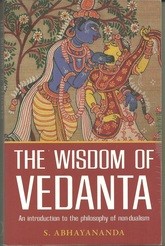
The Wisdom of Vedanta with the subtitle “An Introduction To The Philosophy of Nondualism” by Swami Abhayananda is here presented for free and at full length by the author’s kind permission. Spiritual traditions speak frequently of the bondage of those who live in ignorance of the eternal Self, and the liberation experienced by those who come to know that Self. But the great 13th-century sage, Jnaneshvar, once said that for the enlightened:
“There is neither bondage nor liberation; there is nothing to be accomplished. There is only the pleasure of expounding.”
The purpose of this book on Vedanta is not to liberate anyone from their bondage. After all, no one may remove those imaginary bonds from another – not even by the writing of a million books or by expounding words of wisdom from now till doomsday, writes Swami Abhayananda, whose books and articles may be read and freely downloaded on his website at www.themysticsvision.weebly.com. He has graciously allowed us to offer them here as well. Thanks to him for letting us have his 428-page book on Vedanta and nonduality here:
 The Wisdom of Vedanta
The Wisdom of Vedanta
You can buy the print version here: Link
What is non-dualism in Hinduism?
Nondualism, also known as Advaita Vedanta, is a philosophical and spiritual concept within Hinduism that emphasizes the fundamental unity and interconnectedness of all existence, asserting that there is ultimately only one true reality, often referred to as Brahman. This concept is rooted in ancient Indian scriptures, particularly in the Upanishads, philosophical texts exploring the nature of reality, consciousness, and the self.
Key tenets of nondualism in Hinduism include:
1. Brahman: Nondualism teaches that there is an ultimate reality called Brahman, which is the underlying essence of all existence. Brahman is beyond all limitations, definitions, and characteristics. It is often described as being infinite, eternal, and beyond time and space.
2. Atman: The concept of Atman refers to the individual self or soul. Nondualism asserts that the individual self (Atman) is not separate from the ultimate reality (Brahman). In other words, the true nature of the individual self is the same as the nature of Brahman.
3. Maya: Nondualism explains that the perceived diversity and multiplicity of the world is a result of Maya, which is the illusion of separateness. Maya causes us to perceive the world as made up of distinct objects and beings, when in reality, everything is an expression of the same underlying Brahman.
4. Jiva and Isvara: The individual soul (jiva) is often seen as a reflection of Brahman that has become identified with the physical body and the ego. The divine aspect or cosmic consciousness (Isvara) is considered a manifestation of Brahman that guides the universe.
5. Self-Realization: The central goal of nondualistic philosophy is to realize the inherent oneness between the individual self (Atman) and the ultimate reality (Brahman). This realization is achieved through self-inquiry, meditation, and introspection, often guided by a spiritual teacher or guru.
6. Neti Neti: This phrase, which means “not this, not this,” is a way of negating all conceptualizations and attributes to describe Brahman. Nondualists often explain Brahman by stating what it is not, since it transcends all definitions.
The most prominent exponent of Advaita Vedanta was Adi Shankaracharya, an ancient Indian philosopher and theologian. He systematized the teachings of nondualism and emphasized the importance of understanding and experiencing the underlying unity of existence.
Nondualism has had a significant impact on Hindu philosophy, spirituality, and mysticism, influencing various schools of thought and spiritual practices. It encourages individuals to transcend dualistic thinking and experience a direct connection with the ultimate reality, leading to spiritual liberation (moksha) and a sense of profound peace and unity.


The Corrected website link: http://www.themysticsvision.com is a valid one.
S.A.
Website link is wrong.
Correct link:
https://www.themysticsvision.com/